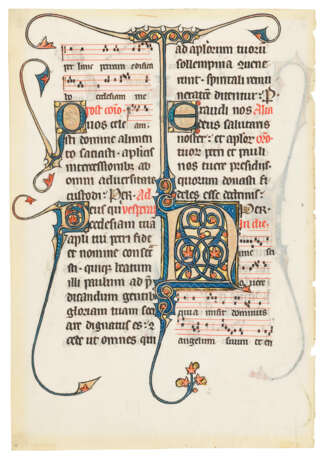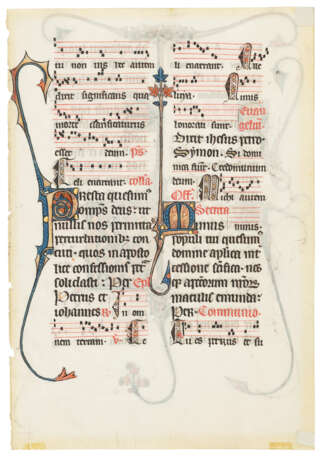ID 1349757
Lot 2 | The Beauvais Missal
Estimate value
£ 3 000 – 5 000
A leaf from the Beauvais Missal, illuminated manuscript on vellum [Northern France, perhaps Beauvais or Amiens, late 13th or early 14th century]
A leaf from an important and famous illuminated Missal – the third of a three-volume set – owned by Beauvais Cathedral in the 14th century and William Randolph Hearst in the 20th.
286 x 199mm, 2 columns of up to 21 lines each in a high-quality formal Gothic bookhand, ruled space: c.200 x 140mm, the text, from the Sanctorale, with the Vigil of Sts Peter and Paul (28 June) and the Feast of Sts Peter and Paul (29 June): '[...] tu non vis hec autem' to 'dominus angelum suum et eri[...]', music in square notation on a 4-line red stave, rubrics in red, calligraphic initials in black ink touched in yellow, one very large initial 'N' ('Nunc scio vere') extending into a bar border, 5 illuminated initials with foliate extensions (a little marginal yellowing, else in excellent condition).
Provenance:
(1) Robert de Hangest (d.1356), canon of Beauvais Cathedral, his gift to the Cathedral just before his death. The parent manuscript of 309 leaves contained an undated inscription recording that Robert de Hangest's death be commemorated every year on November 3. Peter Kidd has reconstructed the early history of this Missal (see P. Kidd, 'The Early Provenance of the Beauvais Missal', blogpost, Medieval Manuscripts Provenance, 3 January 2015) and suggests that the manuscript could have been commissioned for the young Robert by his relative Guillaume de Hangest, Trésorier de France, who in 1294 founded a chapel in the Beguine house in Beauvais. The intact Missal was still at Beauvais in the 17th century, recorded as 'Missale Roberti de Hangesto; en beau vélin et belles miniatures'.
(2) Didier Petit de Meurville (1793–1873), of Lyon; his sale, 1843, lot 354.
(3) Henry-Auguste Brölemann (1775–1854), of Lyon, by descent to his great grand-daughter, Blanche Bontoux (1859-1955), also known as Madame Etienne Mallet, her sale at:
(4) Sotheby's, London, May 4, 1926, lot 161, purchased by William Permain (i,e, Thomas Watson Perman, b.1867) for:
(5) William Randolph Hearst (1863–1951). Sold by Gimbel Bros New York, 1942 to:
(6) Philip C. Duschnes (1897-1970), New York book dealer, who doubtless broke up the volume and sold a number of leaves to:
(7) Otto F. Ege (1888-1951) of Cleveland. Several leaves were offered in Ege's 'Fifty Original Leaves of Medieval Manuscripts' portfolios, the present leaf was among the more expensive, priced at $40 (on Ege, see S. Gwara, Otto Ege's Manuscripts, 2013, the Beauvais Missal leaves listed are HL 15, pp.122-123).
(8) James Eckerling Antiques, October 2022, where acquired by the present owner.
Illumination:
The historiated initials have sometimes been attributed to the artist of the Hours of Yolande of Soissons (Morgan Library, MS M.729), made at Amiens in the 1280s, and while this attribution has not been widely accepted, it is notable that Hangest (from whence came the manuscript’s earliest recorded owner) is only ten miles north-west of Amiens, a likely origin for the artist of the Missal. Alison Stones has instead linked the Missal to a cluster of manuscripts illuminated by the so-called 'Cholet Group' (as named by Robert Branner in 1977), comparing it to a Psalter in Paris, Bibliothèque de l'Arsenal, Ms 25, especially in the treatment of the curling hair, deeply modelled drapery, and the delicately drawn eyes (see A. Stones 'Les manuscrits du cardinal Jean Cholet et l’enluminure beauvaissienne vers la fin du XIIIème siècles', L’Art gothique dans l’Oise et ses environs, XIIème - XIVème siècle: architecture civile et religieuse, peinture murale, sculpture et arts précieux, etc.: colloque international organisé à Beauvais les 10 et 11 octobre 1998 par le G.E.M.O.B., Groupe d’étude des monuments et œuvres d’art de l’Oise et du Beauvaisis, 2001, pp.239-68.
Many leaves are now in institutions and collections throughout the United States and Europe, including the Metropolitan Museum of Art, Cleveland Museum of Art, Pierpont Morgan Library, Houghton Library, and Boston Public Library.
| Place of origin: | Western Europe, France, Europe |
|---|---|
| Auction house category: | Medieval & renaissance manuscripts, Books and manuscripts |
| Place of origin: | Western Europe, France, Europe |
|---|---|
| Auction house category: | Medieval & renaissance manuscripts, Books and manuscripts |
| Address of auction |
CHRISTIE'S 8 King Street, St. James's SW1Y 6QT London United Kingdom | |
|---|---|---|
| Preview |
| |
| Phone | +44 (0)20 7839 9060 | |
| Buyer Premium | see on Website | |
| Conditions of purchase | Conditions of purchase |




